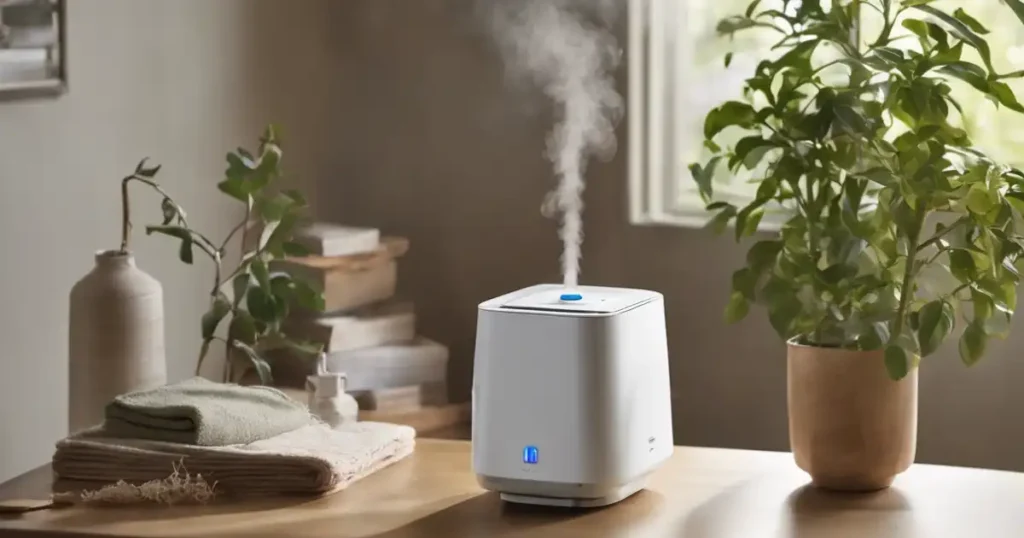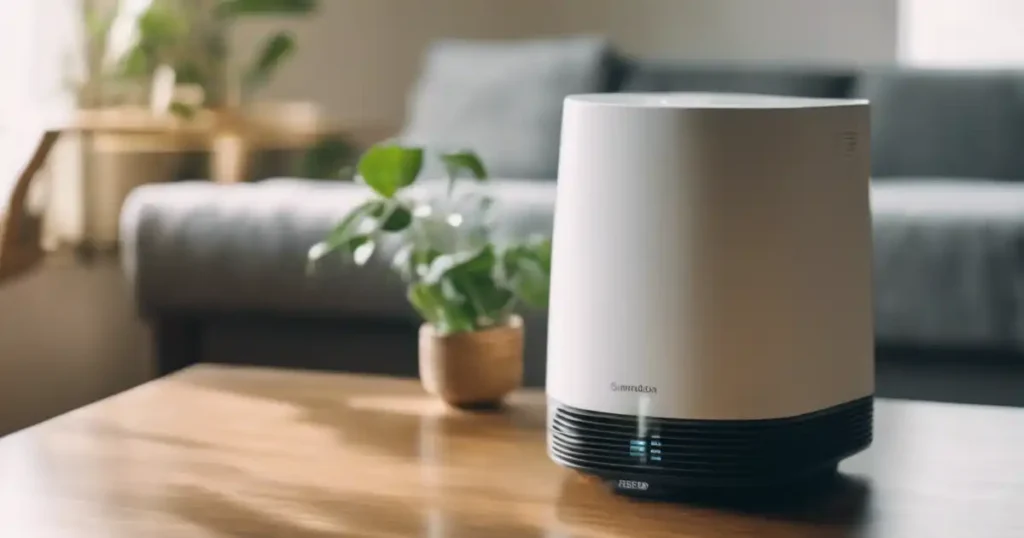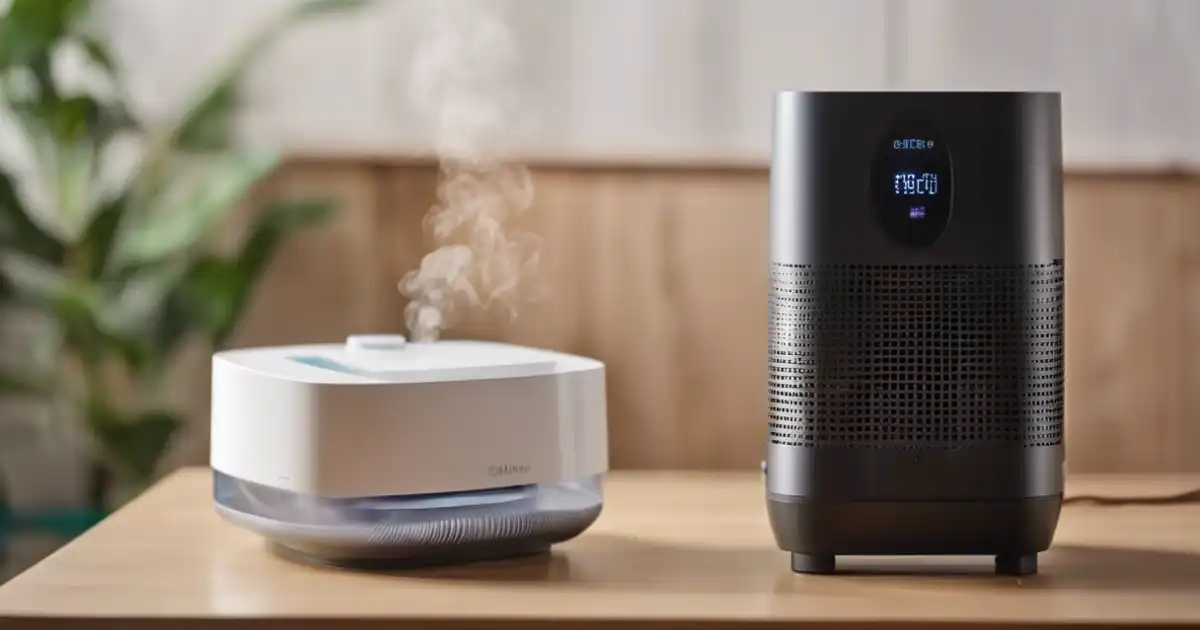We spend approximately 90% of our time indoors, unaware that our homes may be harboring a multitude of irritants and pollutants. These unseen troublemakers silently accumulate, impacting our well-being over time.
So, how can you strip away these contaminants and breathe easier in your sanctuary?
This is where air purifiers and humidifiers come in. These ingenious appliances work round the clock to optimize indoor air quality.
However, a common question that pops up is: Can you use an air purifier and humidifier together?
Absolutely! You can totally use a humidifier and air purifier together. The humidifier adds that much-needed moisture, while the air purifier tackles pollutants.
Curious to know more about using these dynamic duos? Keep reading to discover the benefits and essential factors to consider while using these two appliances.
Air Purifier vs Humidifier: What’s The Difference?
While both humidifiers and air purifiers deal with indoor air quality, they have distinct functions.
An air purifier primarily eliminates contaminants from the air. This includes everything from pollen, pet dander, mold spores, and dust mites to some bacteria and viruses.
It pulls in room air and forces it through specialized filters to trap most particles measuring 0.3 microns or larger. Some high-end models also feature activated carbon layers that help absorb odors and VOCs.
Meanwhile, a humidifier mainly increases low moisture in the air. It releases a cool water vapor mist that raises indoor humidity up to an ideal 30-50% level.
Boosting humidity combats issues tied to excessively dry air during arid winter months. This includes itchy skin, sore throat, cracked lips, and aggravation of respiratory problems like asthma. Moreover, optimum moisture levels also slow down airborne virus transmission rates.
| Aspect | Air Purifier | Humidifier |
|---|---|---|
| Function → | Removes airborne particles | Adds moisture to the air |
| Air Quality Impact → | Improves air quality | Increases humidity levels |
| Primary Mechanism → | Uses air filters to trap particles | Emits cool water vapor to increase humidity |
| Recommended for → | Allergies, asthma, air quality improvement | Dry climates, winter months |
Now that the fundamental objectives of both appliances are clear, let’s address the main question.
Can You Use an Air Purifier and Humidifier Together?

Yes, absolutely! An air purifier and a humidifier complement each other exceptionally well.
Running suitable models side-by-side in the same room maximizes air quality in your home. It eliminates indoor air contaminants while maintaining cleaner, balanced moisture levels.
As said before, an air purifier specializes in removing indoor pollution in the form of allergens, odors, and particulates. Its filtration system – often featuring a pre-filter, HEPA filter, and activated carbon layer – traps particles, filtering out the vast majority of airborne contaminants.
On the other hand, a humidifier can help in restoring deficient moisture levels indoors. Its cool water vapor emission raises low humidity up to a sweet spot recommended for health and comfort. This alleviates issues related to arid air across seasons.
However, combining appliances does demand paying closer attention to some factors. We will explore suitable setups and best practices later in this blog.
First, let’s look at situations where using both devices together benefits homeowners.
Step-by-Step Guide: Setting Up an Air Purifier and Humidifier in One Room
Perform routine maintenance, such as cleaning the humidifier’s tank and replacing the air purifier’s filters as recommended by the manufacturers.
Step 1: Choose the Right Models
Select an air purifier and humidifier suited for the room size and specific needs (e.g., allergies, asthma, dry skin).
Ensure both devices have compatible features, such as adjustable settings and filters that address your indoor air quality requirements.
Step 2: Find the Optimal Placement
Place the air purifier away from walls and obstructions to ensure maximum airflow.
Position the humidifier centrally but not too close to the air purifier to prevent excess moisture from affecting the purifier’s filters.
Avoid placing both devices near electronics or heat sources.
Step 3: Set Up and Turn On
Fill the humidifier’s reservoir with clean water, preferably distilled, to avoid mineral buildup.
Turn on both devices and set them to the appropriate levels. For the humidifier, aim for a humidity level between 30-50%. For the air purifier, adjust the fan speed based on air quality needs.
Step 4: Monitor and Maintain
Regularly check humidity levels using a hygrometer to ensure they remain within the ideal range.
Perform routine maintenance, such as cleaning the humidifier’s tank and replacing the air purifier’s filters as recommended by the manufacturers.
When Should a Humidifier and an Air Purifier Be Used Together?
So, you won’t always find yourself needing both an air purifier and a humidifier on full blast, right? There are certain times when having this dynamic duo in action effectively improves the air quality.
1. During Dry, Heating Seasons
Chilly winter air inevitably turns up the central heating. But forced air systems blast hot, arid air through ventilation ducts that end up sucking moisture out of indoor spaces.
This excessively desiccates the air and leads to low humidity levels of 20-30%. At this point, all the benefits of a humidifier outlined earlier come into play.
Likewise, cranking up the heat also correlates with more windows staying shut. Consequently, ventilation plummets while indoor air contaminants pile up.
Running an air purifier sweeps out air pollution, including chemicals, pathogens, and so on around the clock. It also circulates heat more evenly without cold spots or stuffiness.
Hence, using both appliances together delivers provides humid and clean air in our homes.
2. Respiratory Ailments and Allergies
Indoor air can severely aggravate pre-existing respiratory issues like chronic sinusitis or asthma. It also exacerbates allergic reactions among sensitive occupants.
Using air purifiers and humidifiers together ensures blanket protection by addressing dryness as well as air purity. This clears away allergy triggers while maintaining cleaner air with balanced moisture.
Benefits of Using an Air Purifier and a Humidifier at the Same Time
- Enhanced Respiratory Comfort
The combo clears away allergen triggers like pollen, pet dander, and mold while ensuring balanced moisture. This alleviates issues like congestion, asthma flare-ups, chronic coughs, etc. Additionally, a humidifier can also enhance overall respiratory comfort and prevent dryness-related discomfort. - Protection Against Infections
Well-humidified filtered air reduces the chance of bacteria and viruses remaining viable. As a result, the possibility of airborne transmission is reduced. So, you breathe easier without constantly catching colds or flu. - Prevention of Dryness Issues
Dry air brings problems like dry skin, irritated eyes, and uncomfortable breathing. Air humidifier adds moisture, solving these issues. Paired with an air purifier, it ensures a comfy space by tackling both humidity and air quality. - Faster Relief for Chronic Issues
For folks with asthma or allergies, pairing up a humidifier and air purifier brings faster relief. The air purifier removes pollutants from the air, and the humidifier keeps airways moist, reducing the risk of flare-ups. - Assurance of Fresh Indoor Air Quality
You can rest easy knowing humidity stays balanced alongside the continuous elimination of odor, chemicals, and all sorts of particulate pollution from the air you inhale within your home.
Using this combo eliminates many practical challenges associated with indoor air quality. But what essential precautions should you account for when using both appliances simultaneously?
6 Factors to Consider Before Using These Appliances Simultaneously

Here are a few vital factors to consider for safe, efficient, and mutually beneficial operation:
1. Maintain a Fair Distance Between Both Units
Keep the air purifier and humidifier reasonably apart instead of beside each other. This prevents direct collision of output air streams that can lead to excess moisture buildup on the air filter.
Avoid placing them in confined spaces or corners, allowing for proper air circulation and ensuring the effectiveness of both devices without compromising their efficiency.
2. Evaluate Room Dimensions:
Consider the size and layout of your room when selecting air purifiers and humidifiers. Choose suitable models with matched CADRs and misting capacities that are ideal for the given room area.
Choosing an air purifier or humidifier that is too large for your space wastes energy. On the other hand, selecting one that is too small may result in inadequate performance.
3. Monitor Humidity Levels:
Monitor the current humidity levels in the room. This helps maintain a comfortable and healthy indoor environment. When using an air purifier and a humidifier together, strive for an optimal balance, avoiding excessive moisture. Too much moisture can lead to mold growth. Keep humidity levels between 30 and 50 percent.
4. Keep Water Reservoirs Clean in Humidifiers:
If not cleaned on time, the humidifier may give off mold and mildew. So, change the water in the air humidifier daily to keep it fresh and pure. Hard water leaves mineral deposits over time, so scrub inside tanks weekly to remove the built-up film. Also, disinfect the reservoir monthly to prevent germs from spreading through the moisture vapor.
5. Stick to Maintenance Routines:
For both appliances, stick to the cleaning and part replacement routines suggested in device manuals. Timely upkeep is crucial. It ensures these devices work efficiently, preventing underperformance or other issues. This proactive approach minimizes the risk of malfunctions, ensuring your air purifier and humidifier consistently deliver optimal performance.
6. Shut Off Humidifier When Not Required:
Consider environmental factors when operating the humidifier. Use the humidifier judiciously only when required instead of having it run 24/7. During rainy, damp weather, switch it off to save energy. Run it just enough to prevent excessive room dryness during cold, windy, or arid conditions.
Final Thoughts
Using an air purifier and humidifier together is a winning combo that takes your indoor air quality to the next level. The air purifier filters out allergens, chemicals, odors, and irritants from the air, while the humidifier restores moisture balance.
Together, they alleviate issues tied to stale, contaminated air and arid conditions indoors. This dynamic duo relieves respiratory conditions faster while preventing seasonal dry air problems.
Just be sure to manage both appliances properly – keep them reasonably apart, monitor humidity, and stick to cleaning routines.
So don’t hesitate to team up a humidifier and an air purifier to improve the quality of your indoor air. This small step cultivates cleaner air and better health for all.
FAQs
Is it good to sleep with an air purifier and humidifier?
Certainly! Sleeping with an air purifier or a humidifier can be beneficial. An air purifier improves air quality by removing airborne particles, allergens, and pollutants. Similarly, a humidifier adds moisture to the air, preventing dryness and potential discomfort. Together, they contribute to creating a comfortable and clean sleeping environment.
Is it better to have a humidifier or air purifier?
It depends on your specific needs. If you’re dealing with dry air and want to maintain optimal humidity levels, a humidifier is more suitable. On the other hand, if you’re concerned about airborne particles, allergens, and overall air quality, an air purifier is the better choice. In some cases, using both devices simultaneously can effectively help in improving indoor air quality.
How close can a humidifier be to an air purifier?
Maintain a reasonable distance between a humidifier and an air purifier. Placing them a few feet apart is advisable to prevent direct interaction between their output air streams.
Is a humidifier or purifier better for a stuffy nose?
A humidifier is generally better for relieving a stuffy nose caused by dry air. It adds moisture to the air, preventing nasal passages from drying out and helping to alleviate congestion. While an air purifier can help remove allergens and particles, it does not directly address nasal irritation.
Which is better for mold, air purifier or humidifier?
Use air purifiers to address mold issues. They are designed to capture and remove airborne particles, including mold spores. They use filters and other technologies to trap and eliminate these particles from the air, reducing the overall mold concentration.

